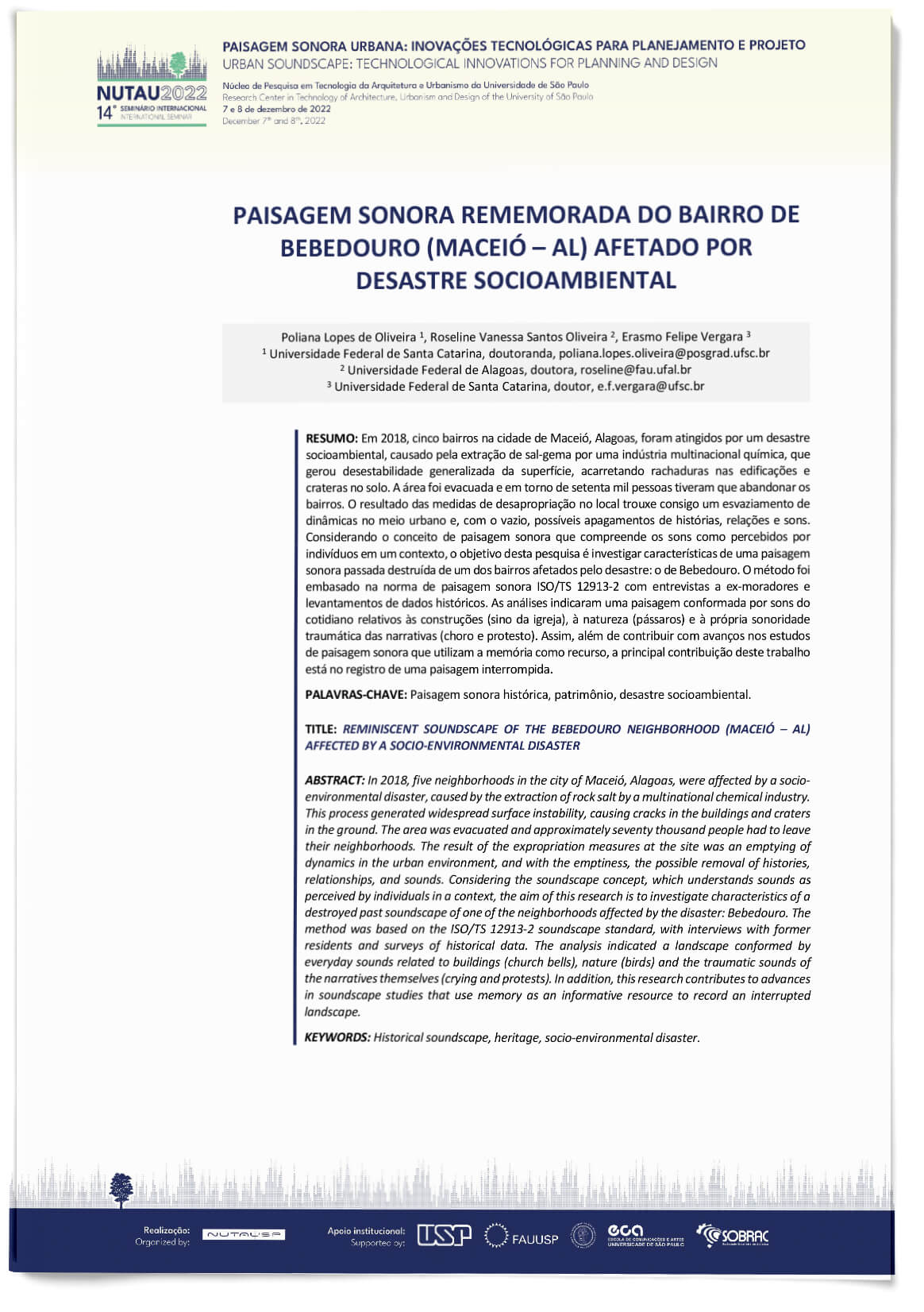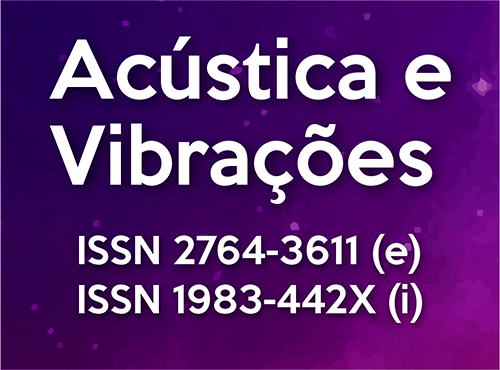Reminiscent soundscape of the Bebedouro neighborhood (Maceió – AL) affected by a socio-environmental disaster
DOI:
https://doi.org/10.55753/aev.v38e55.235Keywords:
historical soundscape, heritage, socio-environmental disasterAbstract
In 2018, five neighborhoods in the city of Maceió, Alagoas, were affected by a socio-environmental disaster, caused by the extraction of rock salt by a multinational chemical industry. This process generated widespread surface instability, causing cracks in the buildings and craters in the ground. The area was evacuated and approximately seventy thousand people had to leave their neighborhoods. The result of the expropriation measures at the site was an emptying of dynamics in the urban environment, and with the emptiness, the possible removal of histories, relationships, and sounds. Considering the soundscape concept, which understands sounds as perceived by individuals in a context, the aim of this research is to investigate characteristics of a destroyed past soundscape of one of the neighborhoods affected by the disaster: Bebedouro. The method was based on the ISO/TS 12913-2 soundscape standard, with interviews with former residents and surveys of historical data. The analysis indicated a landscape conformed by everyday sounds related to buildings (church bells), nature (birds) and the traumatic sounds of the narratives themselves (crying and protests). In addition, this research contributes to advances in soundscape studies that use memory as an informative resource to record an interrupted landscape.
References
(1) International Organization for Standardization (2014). Acoustics — Soundscape — Part 1: Definition and conceptual framework (ISO Standard N° 12913-1). https://www.iso.org/standard/52161.html.
(2) Kang, J. et al. (2016). Ten questions on the soundscapes of the built environment. Building and Environment, 108, 284–294. DOI: 10.1016/j.buildenv.2016.08.011. DOI: https://doi.org/10.1016/j.buildenv.2016.08.011
(3) Labelle, B. (2010). Acoustic Territories: Sound culture and everyday life. Berlim, Continuum.
(4) Gan, Y. et al. (2014). Multi-sensory landscape assessment: The contribution of acoustic perception to landscape evaluation. The Journal of The Acoustical Society of America, 136(6), 3200–3210. DOI: https://doi.org/10.1121/1.4898424
(5) Liu, J. et al. (2019). Effects of soundscape perception on visiting experience in a renovated historical block. Building and Environment, 165, 106375. DOI: https://doi.org/10.1016/j.buildenv.2019.106375
(6) Jia, Y.; Ma, H.; Kang, J. (2020). Characteristics and evaluation of urban soundscapes worthy of preservation. Journal of Environmental Management, 253, 109722. DOI: https://doi.org/10.1016/j.jenvman.2019.109722
(7) Maffei, L.; Brambilla, G.; Di Gabriele, M. (2016). Soundscape as Part of the Cultural Heritage. In: J. Kang; B. Schulte-Fortkamp (Eds.). Soundscape and the Built Environment, CRC Press, 9, 215–242. DOI: https://doi.org/10.1201/b19145-10
(8) Zhang, Y. et al. (2021). Effects of Soundscape on the Environmental Restoration in Urban Natural Environments. Noise and Health, 19(87), 65-72. DOI: 10.4103/nah.NAH-73-16.
(9) Balbontín, S. (2020). The sensitive experience of soundscape within a natural disaster: The case of the tsunami of 27f in Caleta Tumbes, Talcahuano, Chile. Architecture, City and Environment, 14(42). DOI: 10.5821/ace.14.42.7007. DOI: https://doi.org/10.5821/ace.14.42.7007
(10) McAlister, E. (2012). Soundscapes of Disaster and Humanitarianism: Survival Singing, Relief Telethons, and the Haiti Earthquake. Small Axe, 16(3 39), 22–38. DOI: 10.1215/07990537-1894078. DOI: https://doi.org/10.1215/07990537-1894078
(11) CPRM, Serviço Geológico do Brasil. (2019). Relatório de Análise de Subsidência dos Bairros Mutange e Pinheiro.
(12) Schafer, R. M. (1997). The Soundscape: Our Sonic Environment and the Tuning of the World. NY: Inner Traditions/Bear Company.
(13) De Witte, M. (2018). Encountering Religion through Accra’s Urban Soundscape. Encountering the City, Routledge, 133-150. DOI: 10.4324/9781315579467-8. DOI: https://doi.org/10.4324/9781315579467-8
(14) Oliveira, P. et al. (2021). Mapeamento da paisagem sonora: impactos dos sons da fé. urbe. Revista Brasileira de Gestão Urbana, 13. DOI: 10.1590/2175-3369.013.e20210073. DOI: https://doi.org/10.1590/2175-3369.013.e20210073
(15) Yelmi, P. (2016). Protecting contemporary cultural soundscapes as intangible cultural heritage: Sounds of Istambul. International Journal of Heritage Studies, 22(4), 302–311. DOI: 10.1080/13527258.2016.1138237. DOI: https://doi.org/10.1080/13527258.2016.1138237
(16) Firat, H. B.; Masullo, M.; Maffei, L. A (2020). Methodology for the historically informed soundscape. Proceedings of 2020 International Congress on Noise Control Engineering, INTER-NOISE 2020. Anais.
(17) International Organization for Standardization (2018). Acoustics — Soundscape — Part 2: Data collection and reporting requirements (ISO Technical Specification N° 12913-2). https://www.iso.org/standard/75267.html.
(18) Associação Brasileira de Normas Técnicas (2019). Acústica — Medição e avaliação de níveis de pressão sonora em áreas habitadas — Aplicação de uso geral (ABNT NBR 10151).
(19) Maceió. Dados Vetoriais de Maceió [SHP]. Disponível em: https://dados.al.gov.br/catalogo/ dataset/municipio-de-maceio/resource/dc607795-6bc9-4289-833e-d45b7470e532.
(20) Lemos, J. (2003). Bebedouro, Comunidade de História e de Fé. 1ª Edição. Maceió.

Published
How to Cite
Issue
Section
License
Copyright (c) 2023 Acoustics and Vibrations (Acústica e Vibrações)

This work is licensed under a Creative Commons Attribution-NonCommercial-ShareAlike 4.0 International License.




